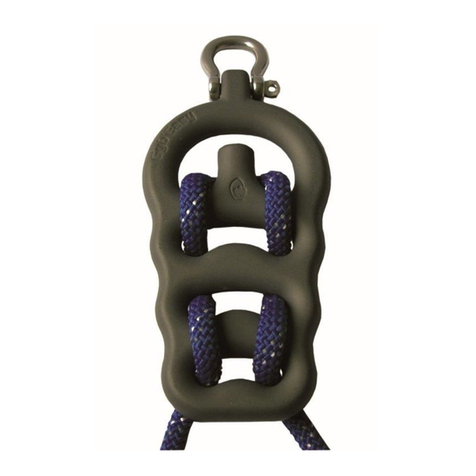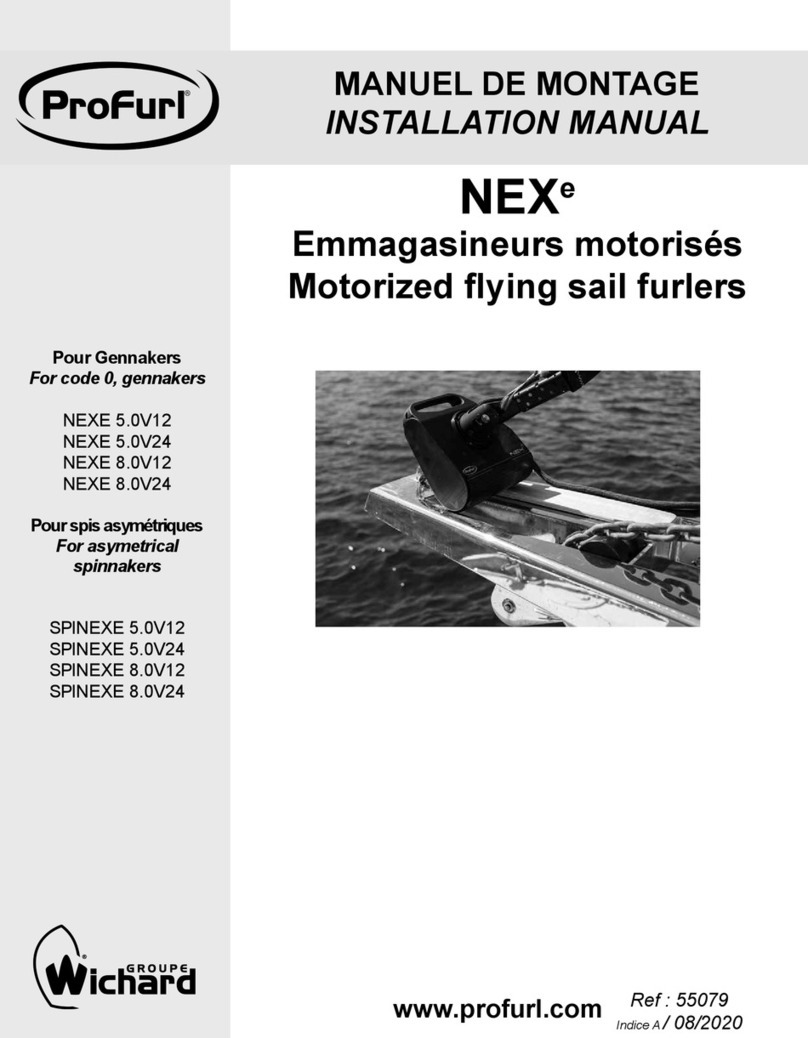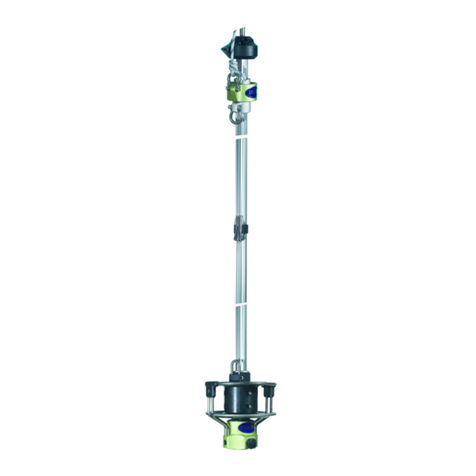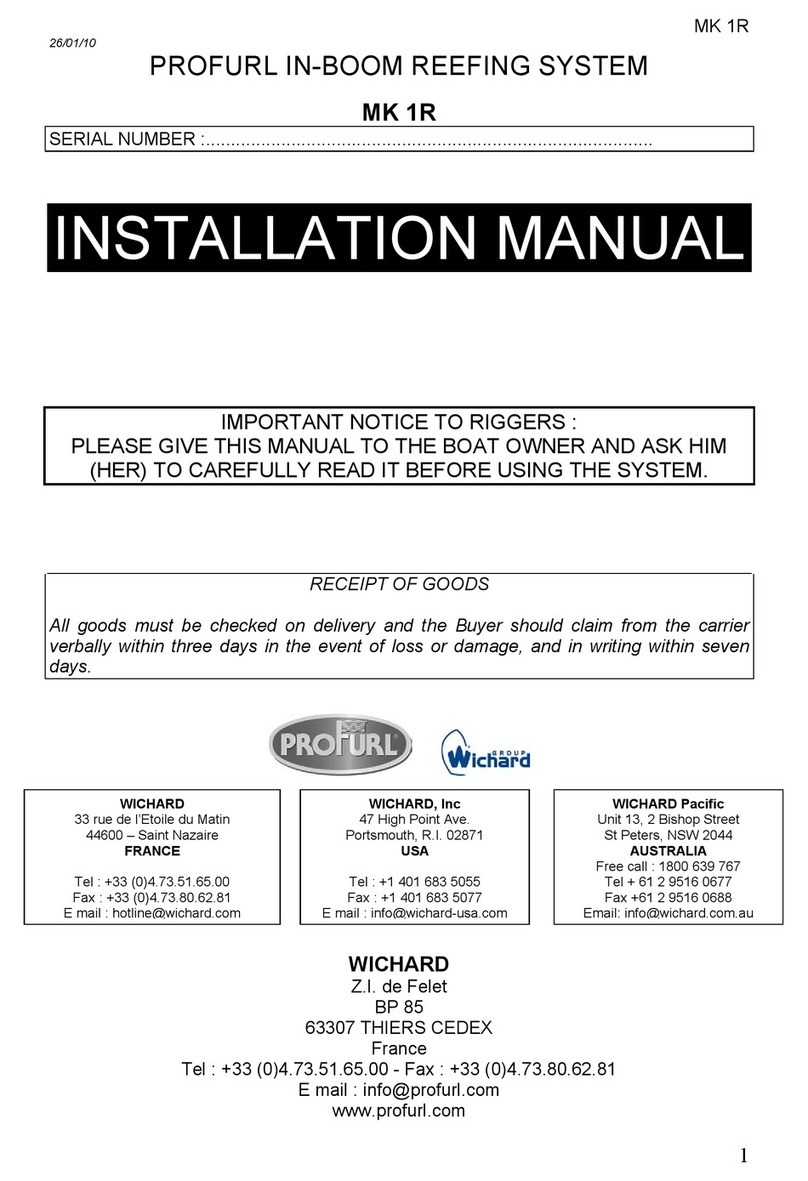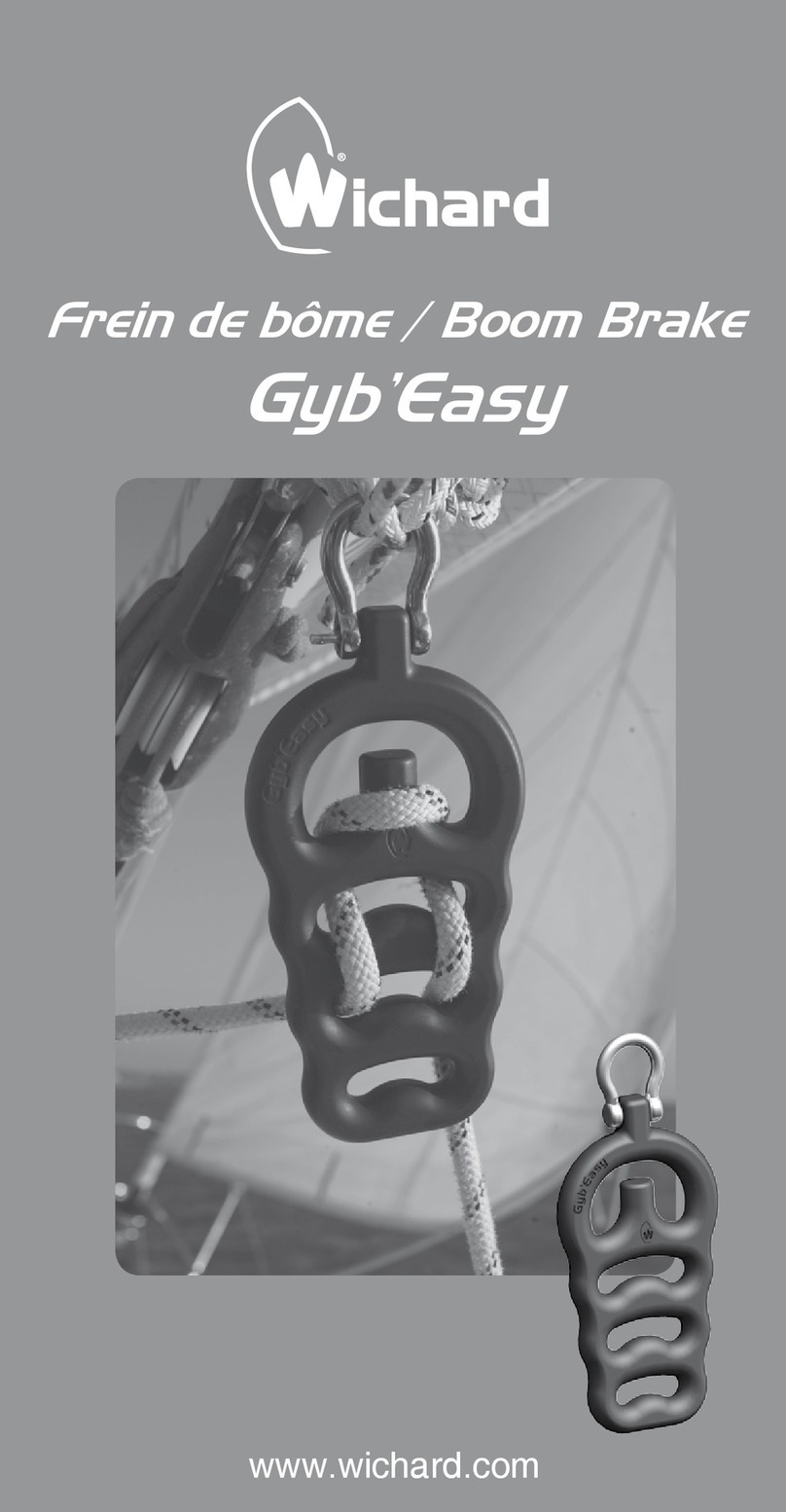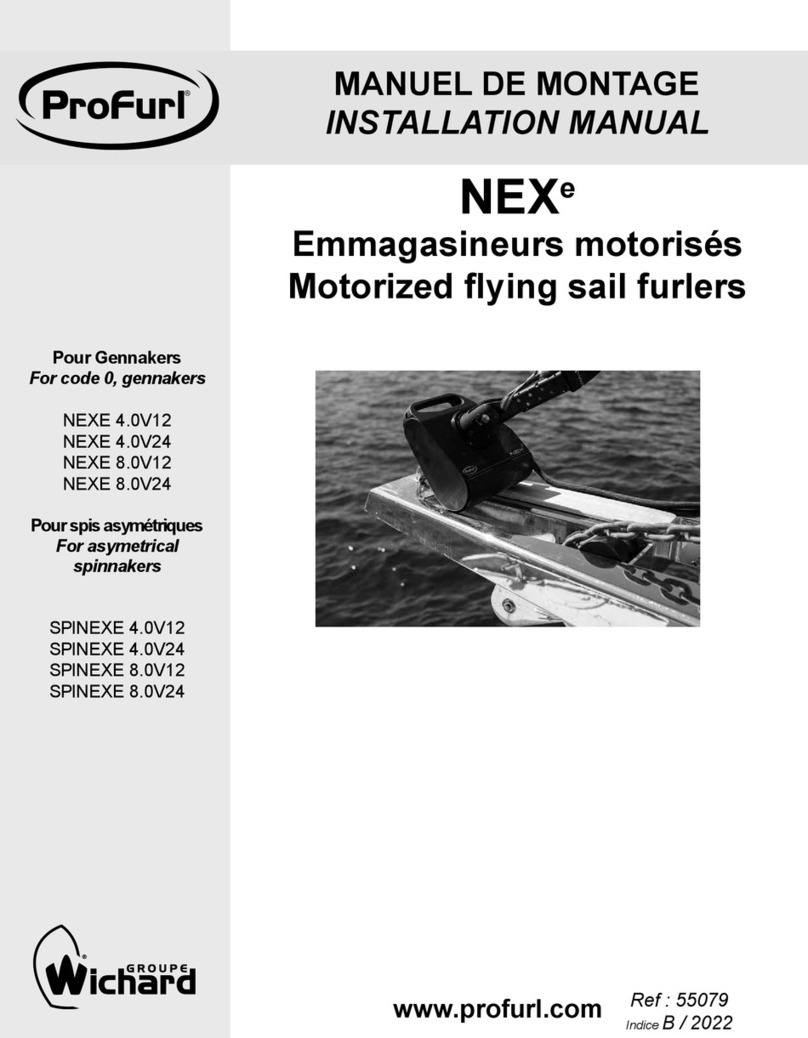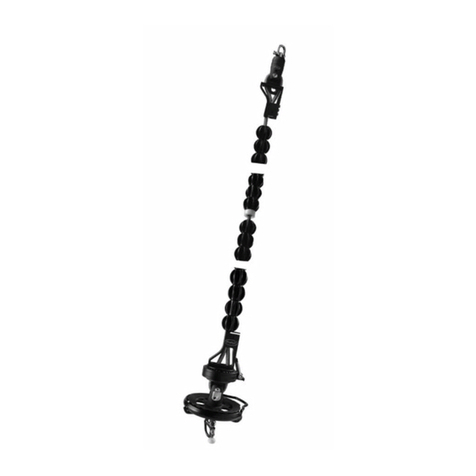
5
ENGLISH
2) Autre possibilité d’installation avec un seul retour au cockpit: voir page 3 schémas 3 et 4
Dans le cas ou l’implantation recommandée n’est pas envisageable, il est possible d’installer le frein de bôme avec un seul retour
au cockpit. Toutefois ce type d’installation nécessite plus de précision de réglage à l’installation, offre moins de souplesse au
freinage et est moins adapté aux grand-voiles de petite taille.
Dans ce cas, le cordage Gyb’Flex ne retourne pas au cockpit, c’est un cordage marin ‘’standard’’ (non fourni) monté en palan qui
permet de régler la tension à partir du cockpit.
Etape 1 : Choix des points d’ancrage (F) du cordage Gyb’Flex:
ex: cadènes de bas hauban arrière (schéma 3).
Etape 2 : Installation des poulies (C):
Fixer la poulie C1 sur un pontet sous la bôme en arrière du hale-bas puis la C2 au pied de mât suivant le schéma 4. Voir tableau
de sélection des poulies page 3. Attention, dans tous les cas, la longueur AC1 doit être sensiblement égale aux longueurs AF. En
l’absence de pontet il est possible de xer le frein avec un brêlage et une retenue pour éviter le glissement du frein vers l’avant.
Toutefois l’installation d’un pontet est recommandée.
Etape 3 : Installation du cordage de commande ‘’standard’’:
Frapper un cordage ‘’standard’’ à la manille du frein de bôme, le faire passer dans les poulies C1 et C2, puis le faire revenir au
cockpit sur un bloqueur ou directement sur un winch. Voir schéma 4.
Etape 4 : Positionnement du frein de bôme Gyb’Easy:
A l’aide du cordage de commande, positionner le frein Gyb’Easy de façon à laisser une course de tension d’environ 30cm (varia-
ble en fonction de la taille du bateau). Voir schéma 4.
Etape 5 : Installation du cordage Gyb’Flex:
Fixer une extrémité du cordage Gyb’Flex au point d’ancrage bâbord, passer une boucle du cordage dans le frein de bôme en po-
sition 1 (voir photo 5), reprendre le mou du cordage et faire un nœud provisoire sur le point d’ancrage tribord. La distance (d) entre
Gyb’Easy et la poulies C1 doit être d’environ 30 cm (variable selon les bateaux) pour permettre la tension du cordage Gyb’Flex.
Quelques empannages sont nécessaires pour être sûr d’avoir sufsamment de course de réglage (d) et pas trop de distance entre
le frein et la bôme. Voir schéma 4.
Etape 6 : Coupe du surplus de cordage
Après plusieurs empannages et lorsque le bon réglage a été trouvé, recouper le surplus de cordage et conserver le reste comme
cordage de rechange.
III) UTILISATION DU FREIN DE BOME:
> Choisir la position de pré-réglage (nombre de passages dans le frein de bôme) adapté à votre bateau et aux conditions de
navigation.
> Au portant: raidir plus ou moins le cordage Gyb’Flex (ou le cordage de commande standard) pour avoir un passage de bôme en
douceur lors des empannages.
> Au près : mollir le cordage, les virements de bord se font librement.
En cas de changement radical des conditions de navigation nécessitant un changement de réglages.
> Pour votre sécurité, amener le bateau face au vent.
> Relâcher la tension du cordage Gyb’Flex (ou le cordage de commande standard).
> Ressortir la boucle du cordage du frein de bôme.
> Repasser la boucle dans la position la plus adaptée.
IV) GARANTIE:
Wichard garantit tous ses produits contre tout vice de fabrication pour une durée de cinq (5) ans à compter de la date d’achat par
l’utilisateur original. Sont exclus de cette garantie :
> Tout produit qui a été installé de manière inadéquate.
> Tout produit utilisé de manière inappropriée ou pour une application pour laquelle il n’est pas prévu.
> Tout produit non correctement entretenu.
> Tout produit modié sans le consentement écrit de Wichard.
> Tous dommages consécutifs à la corrosion, à l’exposition aux rayonnements ultraviolets ou à l’usure normale des produits.
I) INTRODUCTION:
Thank you for purchasing Gyb’Easy the new Wichard boom brake. We hope that it will bring you great satisfaction.
1) Concept :
Gyb’Easy, the Wichard boom brake uses a specic line called Gyb’Flex passing over the boom brake itself. Thanks to its unique
technical features and the frictions on the brake, the boom is allowed to gybe smoothly. The Gyb’Flex rope absorbs the shock
loading. The gybing operation is controlled only by tensioning the Gyb’Flex without any action on the main sheet.
.
2) Settings of Gyb’Easy :
3 different positions exist (see page 4 pictures 5, 6 & 7) for a perfect adaptation to the mainsail area (up to 40 m²) and to the wind
conditions (i.e. sudden increase of wind from 3 to 6 bf). The more times the line passes over the openings of the brake, the more
the friction is increased and hence the brake efciency. As any boom brake, several tests may be useful before getting the right
adjustment. Once the correct setting is found, the strength of the brake can be increased by tensioning the Gyb’Flex. If there is
too much friction, remove one of the lower turns.
3) Limits of use, maintenance and precautions of use :
Limits of use: Gyb’Easy has been designed for a mainsail area under 40 m². CAUTION: good results are only guaranteed when
used with the specic Gyb’Flex line supplied. If replacement of the line becomes necessary, you must use the same type of line
(part # 7148). Please contact your local stockist.
In order to ensure your safety and perfect operation of the boom brake, it is recommended to regularly check the line for wear
and replace it after 5 years.
Maintenance: Gyb’Easy does not require any maintenance. However it is recommended to regularly rinse the brake and the line
with fresh water. During winter the system can easily be dismantled.
Precautions of use: CAUTION : even with a boom brake, it can still be necessary to reef the mainsail. The Gyb’Flex must be
used only for the purpose as described and not for any other applications (halyard, sheet…). Remember: the boom brake does
not substitute common sense and good seamanship !






